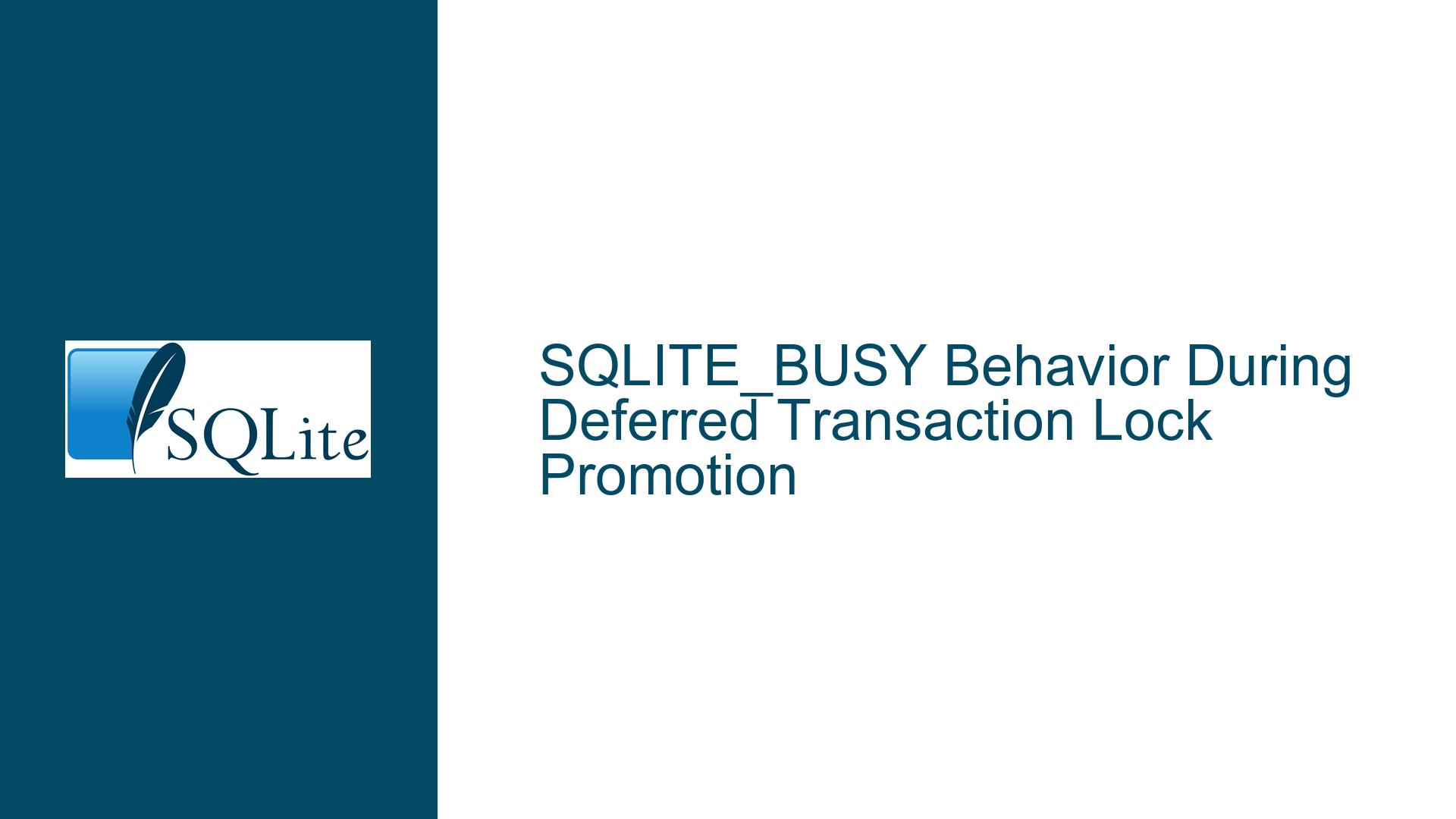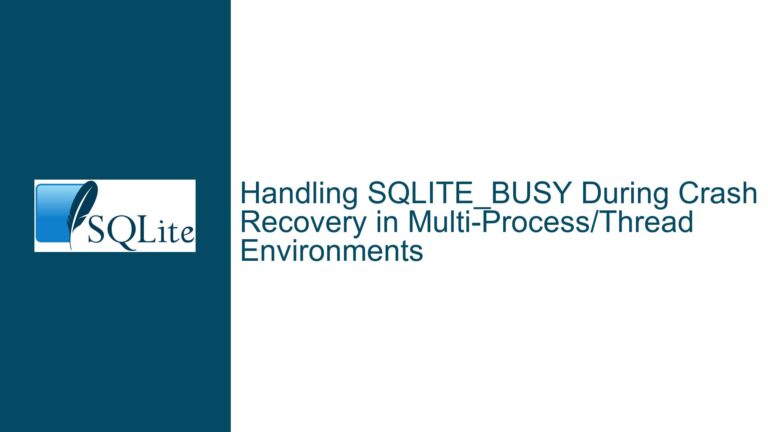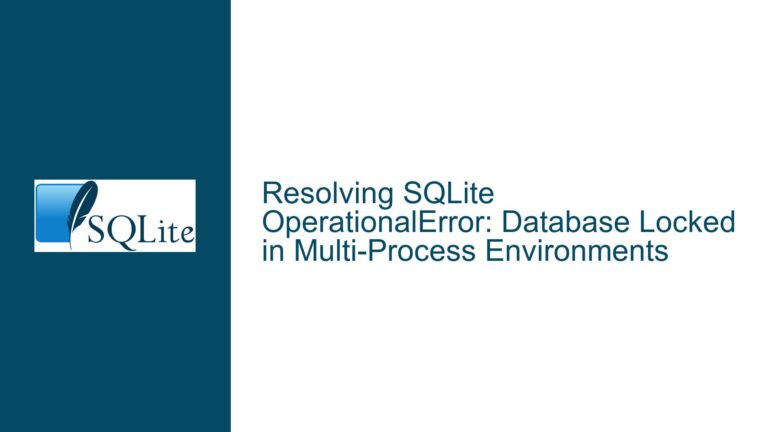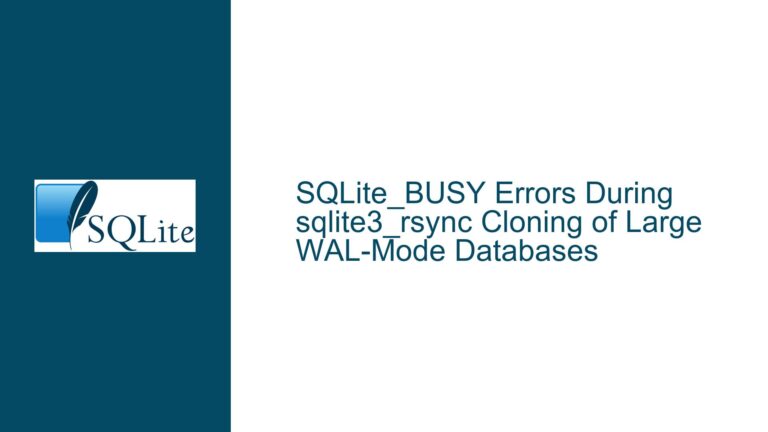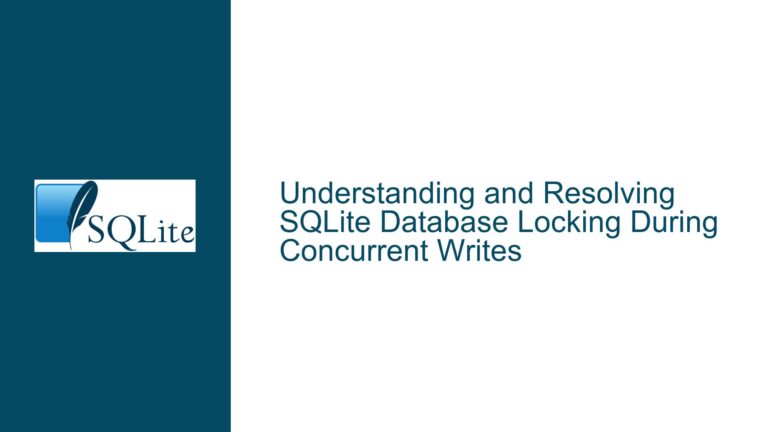SQLITE_BUSY Behavior During Deferred Transaction Lock Promotion
Lock Contention During Deferred-to-Write Transaction Upgrade
When working with SQLite in concurrent environments, developers may encounter unexpected SQLITE_BUSY errors during attempts to upgrade deferred transactions from read to write mode. This occurs when a database connection initiates a transaction using BEGIN DEFERRED, performs read operations, then attempts write operations while another connection holds conflicting locks. The critical observation is that SQLite skips busy handler invocation and immediately returns SQLITE_BUSY in this specific lock promotion scenario, contrary to typical busy timeout expectations.
The behavior stems from SQLite’s locking hierarchy and deadlock prevention mechanisms. A deferred transaction begins with no explicit lock, acquires a SHARED lock during first read access, and attempts to upgrade to RESERVED lock when encountering write operations. If another connection already holds an EXCLUSIVE lock (through BEGIN EXCLUSIVE or implicit write transactions), this lock promotion attempt fails immediately without waiting. This design prevents potential deadlocks that could occur if multiple connections simultaneously tried to upgrade locks while holding conflicting resources.
The WAL (Write-Ahead Logging) journal mode amplifies visibility of this behavior due to its concurrency model. While WAL allows concurrent readers and a single writer, exclusive transactions create persistent conflicts with write attempts from other connections. The Python demonstration reveals this through two connections: one holding an exclusive transaction while another attempts deferred transaction lock promotion. The failure occurs instantly rather than honoring the default busy timeout, which might otherwise suggest retry attempts would eventually succeed.
Lock Hierarchy Constraints and Deadlock Prevention
Three primary factors contribute to this SQLITE_BUSY behavior:
Lock Promotion Sequence Requirements
Deferred transactions follow strict lock acquisition rules: SHARED lock for reads, RESERVED lock for writes, escalating to PENDING and finally EXCLUSIVE during commit. When connection A holds RESERVED (through write statements in deferred transaction) and connection B holds SHARED, SQLite allows concurrent operation. However, if connection B attempts RESERVED lock acquisition while connection A already holds RESERVED, the second connection must wait or fail based on lock contention resolution.Deadlock Avoidance Protocols
SQLite’s lock manager prioritizes deadlock prevention over wait tolerance. When two connections create circular dependencies (A needs resource held by B, B needs resource held by A), the engine breaks the cycle by rejecting later lock requests with immediate SQLITE_BUSY rather than invoking busy handlers. This occurs specifically when both connections attempt lock upgrades rather than simple resource contention between readers and writers.WAL Mode Locking Characteristics
In WAL journal mode, readers maintain SHARED locks while writers use WAL file writes and eventual EXCLUSIVE lock for checkpoint operations. An EXCLUSIVE transaction (BEGIN EXCLUSIVE) in WAL mode doesn’t block readers but prevents other writers from acquiring RESERVED locks. This creates conditions where deferred transaction upgrades fail faster than in DELETE journal mode due to WAL’s write concurrency design.
The interaction between these factors creates non-intuitive failure modes. Developers expecting automatic busy handler intervention during lock contention may misinterpret the immediate SQLITE_BUSY as application-level errors rather than understanding the database engine’s deadlock prevention strategy.
Resolving Immediate SQLITE_BUSY in Lock Promotion Scenarios
1. Transaction Type Selection
Replace DEFERRED transactions with IMMEDIATE when writes are anticipated:
# Original problematic code
con1.execute('begin deferred')
# Resolution: Use immediate transaction
con1.execute('begin immediate')
IMMEDIATE transactions acquire RESERVED lock immediately, eliminating late-stage lock promotion attempts. This forces early contention resolution and enables busy handler engagement if conflicts occur during initial lock acquisition rather than mid-transaction.
2. Busy Timeout Configuration
While busy handlers don’t activate during deadlock-prone lock upgrades, setting timeout values helps other contention scenarios:
# Set 5-second busy timeout for all connections
con1 = sqlite3.connect(db_path, timeout=5)
con2 = sqlite3.connect(db_path, timeout=5)
This affects lock acquisition attempts outside of deadlock-risk scenarios. Combined with proper transaction types, it reduces overall SQLITE_BUSY occurrences while acknowledging some will remain unavoidable due to engine design.
3. Application-Level Retry Logic
Implement retry wrappers for write operations in deferred transactions:
def safe_execute(conn, sql, max_retries=3):
for _ in range(max_retries):
try:
return conn.execute(sql)
except sqlite3.OperationalError as e:
if 'database is busy' not in str(e):
raise
time.sleep(0.1)
raise sqlite3.OperationalError("Max retries exceeded")
This pattern respects SQLite’s failure semantics while providing recovery opportunities for transient lock conflicts not involving deadlock risks.
4. Exclusive Transaction Management
Minimize duration of EXCLUSIVE transactions. Instead of:
con2.execute('begin exclusive')
# ... long-running operations ...
Structure critical sections to acquire locks late and release early:
with con2:
con2.execute('begin immediate')
# Perform minimal write operations
con2.execute('insert ...')
This reduces contention windows where other connections might attempt lock upgrades.
5. Connection Pool Tuning
Limit concurrent writers when using WAL mode. While SQLite supports multiple simultaneous readers, having multiple write-capable connections increases lock promotion failures. Designate single-writer connections for transactional workloads while using read-only connections for queries.
6. Schema Design Considerations
Avoid long-running write transactions that maintain RESERVED locks. Break large batch operations into smaller transactions using SAVEPOINT statements to periodically release locks:
con.execute('begin immediate')
for chunk in data:
con.execute('savepoint batch')
# Process chunk
con.execute('release batch')
con.commit()
This incremental approach allows other connections to interleave lock acquisitions between chunks.
7. Monitoring Lock States
Use PRAGMA statements to diagnose lock contention:
PRAGMA lock_status; -- Shows current connection's lock holdings
PRAGMA wal_checkpoint; -- Forces WAL file truncation in contentious scenarios
Combine with database-level logging to identify persistent contention points requiring architectural changes.
8. Alternative Concurrency Models
For high-concurrency write scenarios, consider wrapping SQLite with application-level mutexes or queue-based write serialization. While SQLite handles many concurrent operations well, extreme write contention may necessitate architecting around its locking model rather than fighting it.
By combining transaction type awareness, timeout configuration, and defensive programming practices, developers can mitigate unexpected SQLITE_BUSY errors while maintaining SQLite’s lightweight deployment advantages. The core principle involves recognizing that deferred transactions trade initial lock acquisition cost for higher risk of mid-transaction failures—a balance that must be consciously managed in write-heavy workflows.
